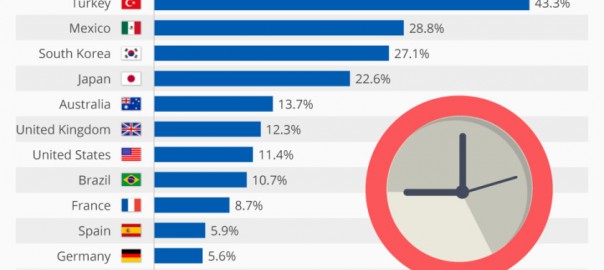
There’s no clear definition for job satisfaction.
When you think about how important employee satisfaction is, the fact that there’s no universally clear definition is a huge problem.
I want to put an end to this once and for all and establish a definition that everyone can use.
Many managers think that the definition is simply how satisfied you are with your work, which is an understandable mistake to make, but it’s more complex than that.
I recently wrote an article called Why Measuring Employee Happiness Is A Huge Mistake where I explained how most managers confuse employee engagement with employee happiness.
By doing this, they miss an opportunity to fully understand what motivates an employee, and their data could be misleading.
Engagement is much more complex than happiness, and managers are making a similar mistake when it comes to defining job satisfaction.
Satisfaction is one of the ten metrics that we measure in Officevibe’s employee engagement software, and I’ll explain exactly what we use to measure that metric.

At a high level, we break Satisfaction down into two main categories:
- Career
- Compensation
Those get broken down further to measure each aspect of what we mean by career and compensation.
Under “Career” we look at the work environment, the workload, and the clarity of the job expectations.
Under “Compensation” we look at both salary and benefits.
Let’s go through each of them one by one.
Free Bonus: Download 22 simple (and free) ways to boost job satisfaction.
Work Environment
Your work environment really affects your satisfaction.
The colors of the walls, whether there are plants, open concept or cubicles all affect how productive and happy you are.
It turns out that many employees don’t think that their office space is conducive to good work. In an international IPSOS survey1, they found that:
84% of workers reported that their work environment did not allow them to concentrate easily, express ideas freely, work in teams without interruption, or choose where to work based on the task at hand.
Companies like Google and Apple have famously designed their office to create the most productive spaces for work and make their employees as satisfied as possible.
Steve Jobs famously designed the Pixar headquarters with central bathrooms so that people from around the company would run into each other.
One thing they do very well is balance the open concept with private spaces to give people the chance to focus.
While not everyone has the budget to design an office like Apple or Google, you can optimize the space to account for different people’s preferences.
Also, offering perks like remote working are a good way to at least find some balance.
Around 70% of American employees work in open-concept offices.
While there is a lot of evidence that open-concept offices lead to more collaboration, they have many downsides too. For introverts (like myself) they’re incredibly distracting.
I get my best work done when I work from home. Something doesn’t sound right about that.
I suppose I could put on my headphones, but that often appears antisocial and as if I don’t like my colleagues (which I do).
The open-office trend began in the 1990s. At the time, there was research that said open work environments led to collaboration and fostered and creativity, so companies started getting rid of cubicles.
There is a growing body of research that is now finding that open offices make us less productive because of all the distractions.
Managers should keep this in mind when setting up workstations.
As an example, most developers like their privacy to be able to focus, whereas product/marketing people often talk a lot to brainstorm new ideas. Putting them all in the same space seems silly.
Workload Satisfaction
If an employee feels overworked, this will affect their job satisfaction.
Unfortunately, many employees across the world are incredibly overworked:
A survey of employees that use email found:
- 22% are expected to respond to work email when they’re not at work.
- 50% check work email on the weekends.
- 46% check work email on sick days.
- 34% check work email while on vacation.
I recently wrote about how technology is destroying our work-life balance, and companies need to start becoming more proactive about managing this.
Most employees are working more and are more stressed than ever.

All of this leads to burnout, which only lowers satisfaction and productivity.
The research is very clear about this, longer hours won’t make you more productive.
In a study published2 by Stanford University, they found that employee productivity falls sharply after 50 hours, and pretty much stays flat after 55 hours.
When they looked at employees that put in 70 hours of work, they found that they produced nothing more than the 55 hour workers.
Longer hours have also been linked to employee turnover.
The easiest thing for managers to do is to make sure they have clear boundaries set for work and life.
Work-life balance is going to become even more important as time goes on and Generation Z workers start working.
Managers should be asking employees frequently if they feel like they have too much work.
Let employees know that it’s okay for them to be honest with you (they’ll often just say no to impress you) and adjust their workload accordingly.
Clarity Of Expectations
Lack of clarity around an employee’s role is a surprisingly big problem. And it’s not only for new employees, many tenured employees experience this as well.
The real problem with a lack of clarity is that it shows a much bigger problem in the organization.
It’s impossible for an organization to be successful when there isn’t clear alignment between its objectives and what people spend their time doing.
If you’re a regular reader of the blog, you’ll be all too familiar with the concept of Objectives and Key Results (OKRs).
The reason we talk about it so much (and use it ourselves) is because it’s the best way to align everyone around a shared goal and then the clarity of roles take care of themselves.
Everyone is on the same page, and everyone is so clear on what their role is, this part of it never affects job satisfaction.
For managers, even if you don’t use OKRs, find a way to align everyone on the team.
Have frequent meetings where everyone is clear about what their role is and how they contribute to the team. Getting that message across is the key to solving this problem.
Salary
This is a tricky one, because often this is out of your control as a manager, and everyone will always want more money if you ask them, but money isn’t a true motivator.
We’ve proved that many times before. Employees aren’t motivated by money, so once you pay them a fair market rate salary, focusing on the intrinsic motivators is what will work to make employees satisfied.
The point about paying a fair market salary is an important one, many managers used to be able to get away with this, but now besides social media, there are many websites to check what the going rate for a job is.
You get what you pay for, so if you want to pay a lower rate, you’ll most likely get a lower quality employee.
Managers have to accept the fact that you have to pay a fair salary or employees will naturally be unmotivated.
This is what’s known as equity theory.
Equity theory is a concept in behavioral psychology that explains how in any relationship, we’re always balancing our input vs the output we get.
When it’s uneven, it affects our mood and satisfaction.
This is an even bigger problem in a working relationship, because not only are employees comparing their input vs what they get back from managers, but also among their coworkers.
Benefits
When salary is something that you can’t change, benefits are a great way to compensate (no pun intended).
Most of the benefits that you can offer are free and very simple to implement.
Here are 20 free ways to reward employees:
Many employees (including myself) would rather have benefits than a higher salary.
The freedom that comes with knowing I could work from home or even go see a doctor without thinking twice is priceless.
Free Bonus: Download 22 simple (and free) ways to boost job satisfaction.
What The Experts Think
I had the opportunity of speaking with Ms. Michael M. Moon, PhD, the Research Director for Aberdeen Group’s Human Capital Management practice. She’s done extensive work in this field and so I asked her for her definition of job satisfaction.

The best definition that exists for job satisfaction was put forth by Edwin Locke in 1976 (kind of the godfather of Organizational Behavior).
“…a pleasurable or positive emotional state resulting from the appraisal of one’s job or job experiences” (Locke, 1976, p. 1304).Ms. Michael M. Moon, PhD
She then goes into much more detail. I suggest reading this part twice, this is one of the smartest people in the field:
Most research, however, has consistently found that one factor consistently impacts job satisfaction and that is the intrinsic challenge present in the work itself. The theory that best supports this comes from Hackman and Oldman’s Job Characteristics Model (JCM) of work motivation (1976).
Additionally, much of the research on engagement has its foundations in the JCM. Certain job characteristics (i.e., task identity, task significance, skill variety, feedback, and autonomy) lead to critical cognitive and affective psychological states that serve to motivate employees and have been linked to higher levels of engagement (Schaufeli & Bakker, 2004).
Employees whose perceive their tasks as being high on core job characteristics are intrinsically motivated to perform well, more satisfied with their job, and less likely to leave their organization (Hackman & Oldham, 1980; Gerhart, 1987; Schaufeli & Bakker, 2004).
Jobs that are low on job characteristics, especially feedback and social support (referred to as job resources), have consistently shown to be related to burnout and exhaustion (Maslach et al., 2001; Schaufeli & Bakker, 2004).
This theory essentially suggests that individuals need to feel mentally challenged in some capacity by their jobs. However, one thing to keep in mind is that like engagement job satisfaction is also context dependent. What satisfies one worker may not satisfy another and things such as “task significance” and “task variety” are based on employee perception.
Additionally, research has also shown that not everyone wants to be mentally challenged in their work. Some individuals have a lower desire for growth in their roles and this too will play a role in the relative importance of these intrinsic job characteristics on job satisfaction.
Lastly, personality plays a significant role in job satisfaction as well (Judge, Locke, Durham, and Kluger, 1988). Judge et al. (1988) found that individuals with a general disposition that is described as positive are more likely to see their jobs in a positive light and undertake jobs that are challenging.
How Would You Define Job Satisfaction?
Do you agree with our definition? Think we left something out? I’d love to hear your thoughts.
Business & Finance Articles on Business 2 Community(133)
Report Post





